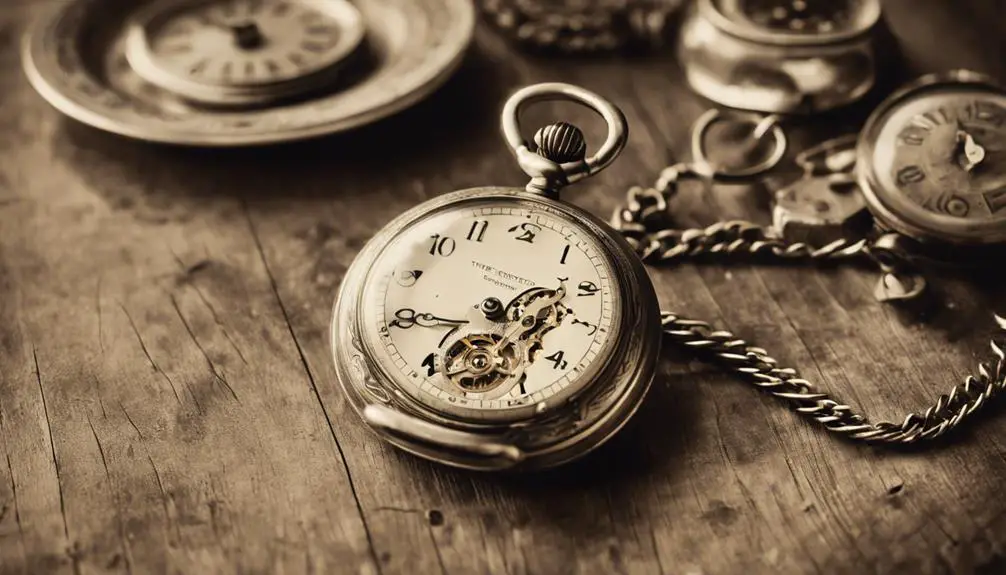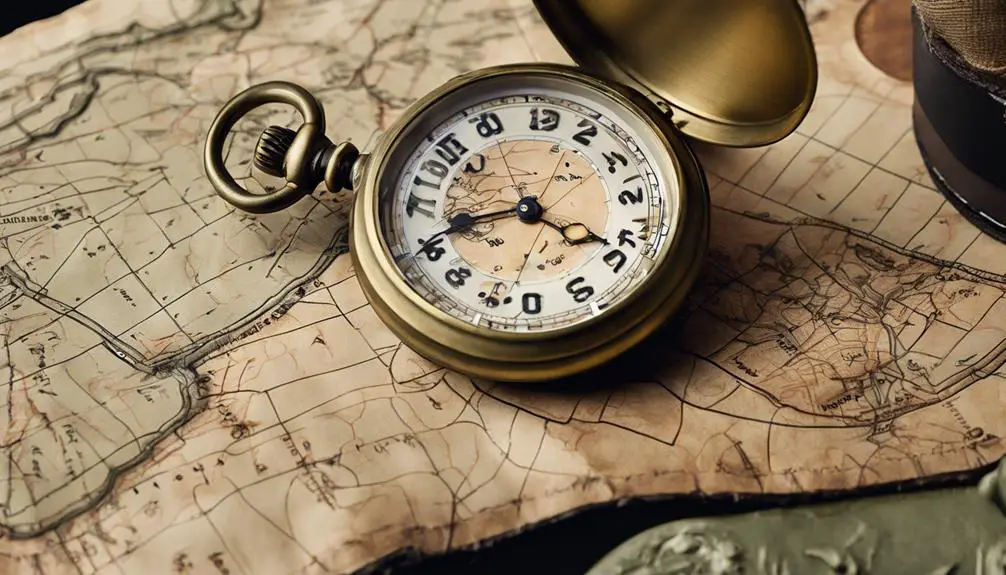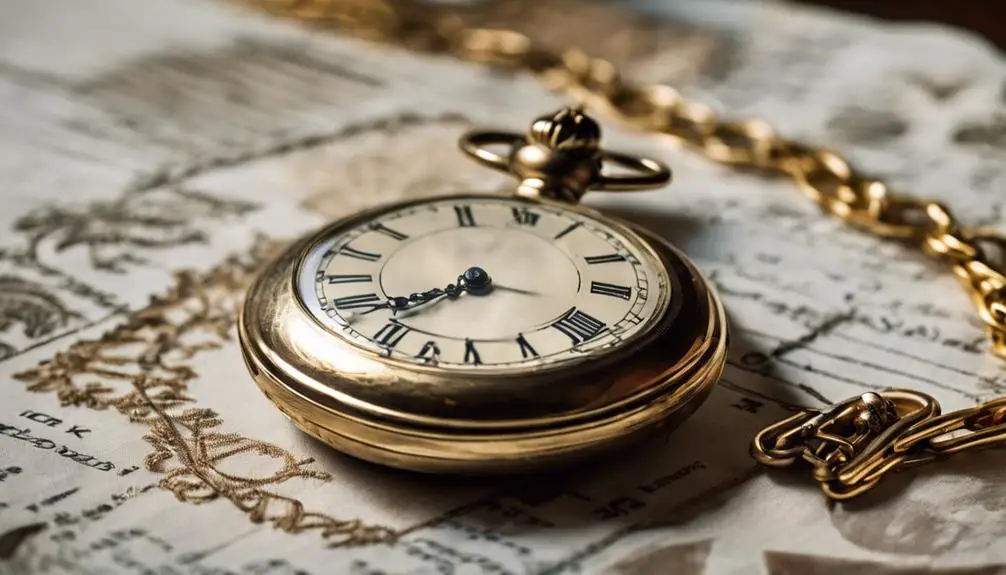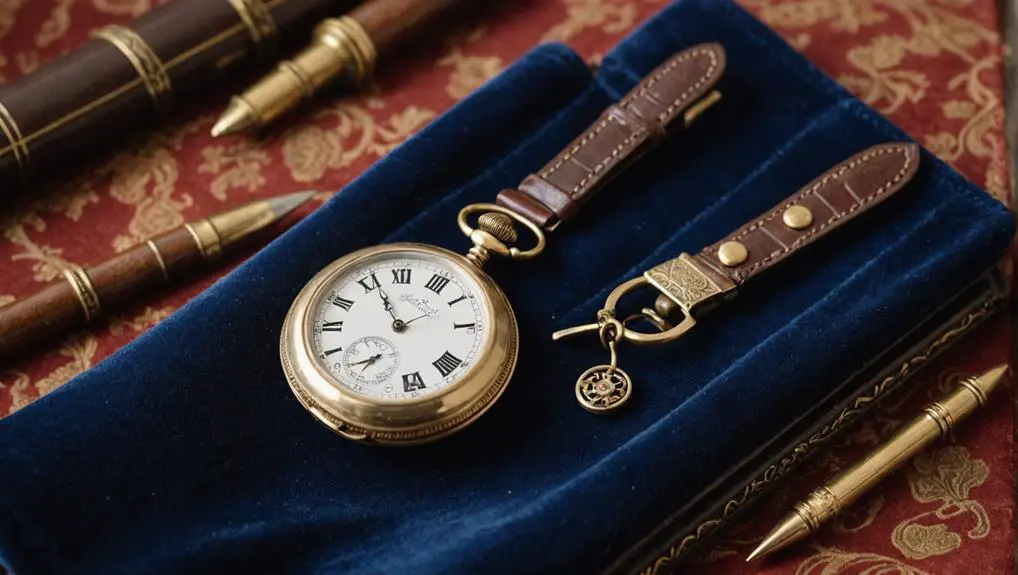Men's pocket watches in the 1940s were heavily influenced by military needs, emphasizing durability and reliability. Brands like Hamilton, Elgin, and Waltham produced iconic models such as the Hamilton 992B, known for its railroad accuracy. Featuring mechanical movements, these timepieces often incorporated stainless steel and gold for resilience. The military's demand led to the development of designs like the Hamilton 4992B, which included luminous dials for low-light conditions. Collectors today find these watches appealing for their craftsmanship and historical significance, impacting market trends and auction prices. You'll discover even more fascinating details about these remarkable timepieces ahead.
Evolution of Pocket Watches

The evolution of pocket watches reveals a fascinating journey marked by technological advancements and changing societal needs. In the 1940s, the design of pocket watches shifted considerably, primarily influenced by military requirements. Brands like Hamilton and Waltham produced Military Pocket Watches that prioritized durability and functionality. These timepieces were engineered to withstand the rigors of war, featuring robust constructions and legible dials vital for quick reading in various conditions.
During this era, mechanical movements dominated the market. Most pocket watches, including the esteemed Hamilton Pocket Watch, utilized manual winding mechanisms, demanding daily attention to guarantee precision. Despite the emerging popularity of wristwatches, pocket watches retained their relevance, particularly in military contexts where reliability was essential.
Post-war, the collectibility of 1940s pocket watches surged, fueled by a nostalgic interest in craftsmanship and historical significance. Notable brands like Elgin and Longines continued to create high-quality models, often adorned with intricate designs and dependable movements. This era solidified the pocket watch's legacy, making it a coveted item for collectors and a symbol of both style and functionality.
Iconic Brands of the 1940s
In the domain of pocket watches during the 1940s, several iconic brands emerged, each leaving a distinct mark on the industry. American brands like Hamilton, Elgin, and Waltham stood out for their durability and reliability, often catering to military needs during World War II.
Hamilton's 992B model became the gold standard for railroad accuracy, demonstrating the brand's commitment to precision. Elgin's B.W. Raymond model, with its elegant design, gained traction among collectors and enthusiasts who appreciated its exquisite craftsmanship. Waltham also made waves with its railroad-grade timepieces, appealing to both consumers and professionals alike.
Additionally, Swiss brands like Longines and Omega produced military-issued pocket watches, emphasizing the durability and functionality required in wartime conditions. These brands not only shaped the market but also set the stage for future innovations in antique pocket watches.
| Brand | Notable Model | Key Feature |
|---|---|---|
| Hamilton | 992B | Railroad accuracy |
| Elgin | B.W. Raymond | Elegant design |
| Waltham | Railroad-grade | Exceptional craftsmanship |
Military Influence on Design

With the rise of iconic brands in the 1940s, military needs directly shaped the design of pocket watches. The U.S. Military sought reliable timepieces that could withstand the rigors of wartime conditions. This led to the development of open face pocket watches, such as the Hamilton 4992B, which featured a 24-hour format and 22 jewels for enhanced functionality and readability—crucial for navigation in the field.
Durability became paramount; brands like Hamilton and Longines utilized robust materials, including stainless steel and gold-plated finishes, to guarantee their watches could endure harsh environments. Luminous dials emerged as a significant feature, allowing soldiers to read the time in low-light situations, which was essential during nighttime operations.
The emphasis on functionality also resulted in simplified aesthetics, reflecting the technological advancements of the era. Swiss-made timepieces gained recognition for their precision and reliability, making them a preferred choice for military use. Consequently, these pocket watches from the 1940s not only fulfilled military requirements but also set a standard for future designs, merging practicality with the craftsmanship of the time.
Collectibility and Market Trends
Surging interest in 1940s pocket watches, especially military-issued models, has reshaped the collectibles market considerably. Auction prices for these timepieces often exceed thousands of dollars, underscoring their historical significance and rarity. Collectors are particularly drawn to notable brands like Hamilton, Waltham, and Elgin, with models such as the Hamilton 992B and Waltham Vanguard standing out for their craftsmanship and durability.
- The thrill of uncovering a rare find
- The satisfaction of owning a piece of history
- The camaraderie among fellow collectors
- The allure of vintage aesthetics
- The potential for investment growth
Condition and provenance are critical in determining value; well-documented pieces in excellent condition command premium prices. Online marketplaces have broadened access for collectors, fostering increased competition and driving up prices for sought-after vintage models. The rise of vintage watch collecting in the 21st century has cultivated a dedicated community, where networking at antique fairs and engaging in online forums become essential for staying informed on market trends. As you navigate this evolving landscape, understanding these dynamics will enhance your collecting experience and investment strategy.
Notable Models and Features

The focus on collectible pocket watches naturally leads to a closer look at specific models that have defined the genre. The Hamilton 992B model emerged as a favorite during the 1940s, renowned for its accuracy and reliability, making it a popular choice among railroad workers and collectors. Similarly, the Hamilton Open Face Pocket watch captured attention with its sleek design and functionality, embodying practicality and elegance.
Another notable model, the Elgin B.W. Raymond, gained accolades for its sophisticated design and quality craftsmanship. Often featuring 21 jewels and a distinctive railroad grade, it appealed to those seeking both aesthetics and precision.
During WWII, Hamilton produced Military Pocket Watches, particularly the 4992B, specifically designed for U.S. Navy navigation. This timepiece showcased 22 jewels and a 24-hour format, emphasizing its role in ensuring precise timekeeping in critical situations.
Vintage 1940s military pocket watches, such as the Bulova Military Issue, are also significant. Their historical relevance and robust construction reflect the demands of wartime use, making them highly sought after by collectors interested in military history.
Craftsmanship and Materials Used
Crafted with precision and an eye for detail, pocket watches from the 1940s stand as tributes to exceptional craftsmanship and the use of high-quality materials. These timepieces often featured robust constructions, utilizing durable materials such as stainless steel and gold, which not only enhanced their aesthetic appeal but also guaranteed longevity. The intricate mechanical movements, typically boasting a jewel count between 17 to 23 jewels, markedly improved their accuracy and reliability.
The Art Deco influence is evident in their designs, with unique cases and dials that seamlessly blended functionality with artistic finesse. Popular American brands like Hamilton and Waltham exemplified this craftsmanship, employing high-quality metals and precision engineering to create timepieces that were both reliable and stylish.
Key elements that evoke the essence of these timepieces include:
- The luxurious feel of gold accents
- The striking Art Deco design elements
- The strength of a steel case
- The precision of the Navigation Master functionality
- The clarity of luminous hands and Arabic numeral markers
In every detail, these watches encapsulate an era of elegance and meticulous craftsmanship.
Frequently Asked Questions
Were Pocket Watches Popular in the 1940s?
Yes, pocket watches maintained popularity in the 1940s. Their practicality, especially among military personnel, and their traditional appeal contributed to their continued use, even as wristwatches began to dominate the market during that decade.
When Did Men Start Wearing Pocket Watches?
Men started wearing pocket watches in the 17th century, as they became practical timekeepers and symbols of status. Their popularity surged in the 19th century, thanks to technological advances and mass production, making them widely accessible.
Were Pocket Watches Used in Ww2?
Yes, pocket watches were widely used during World War II. Military personnel relied on them for their accuracy and durability, making them essential tools for timekeeping in the demanding environments of combat and coordination.
How Do You Date a Vintage Pocket Watch?
To date a vintage pocket watch, examine its serial number, design features, and any stamped codes. Research the brand's history and consult reference materials to accurately identify its production year and style characteristics.





I am glad to be one of several visitants on this outstanding web site (:, thanks for putting up.